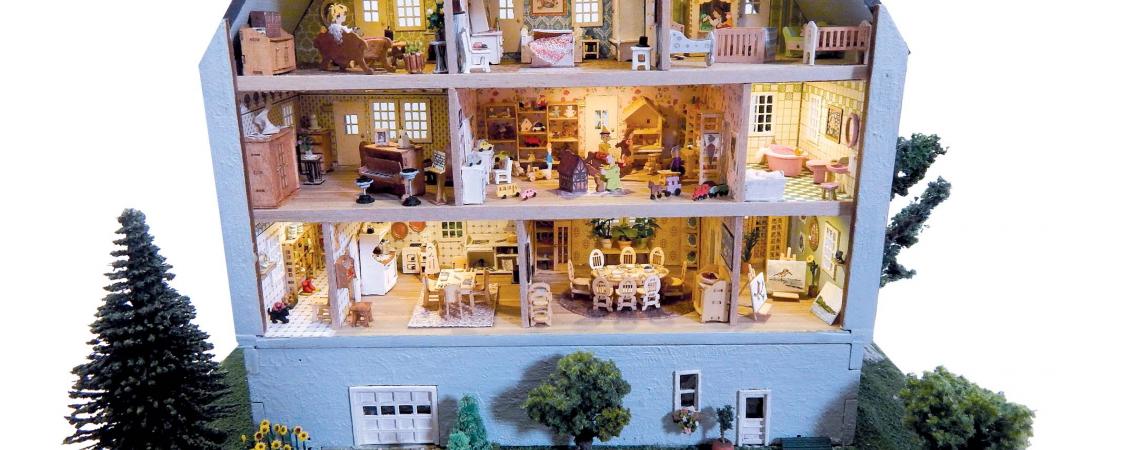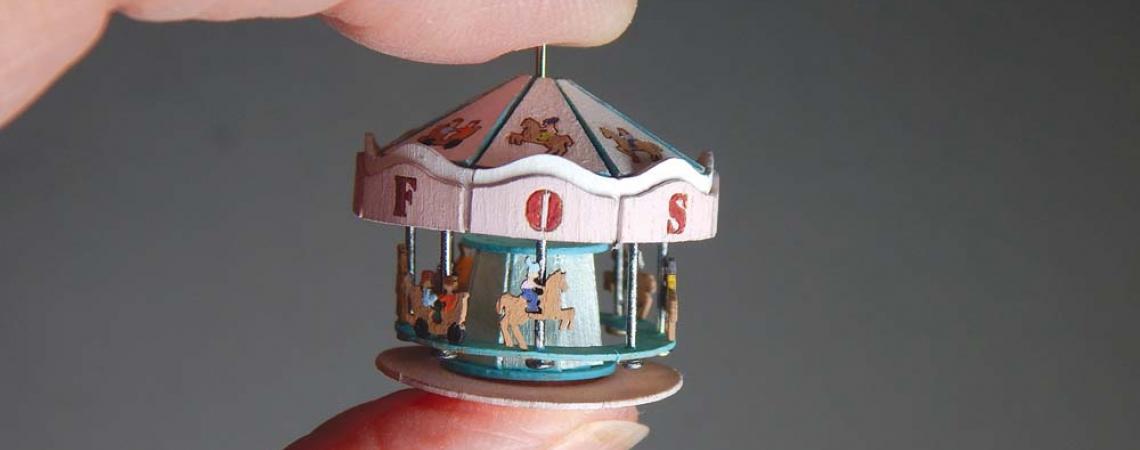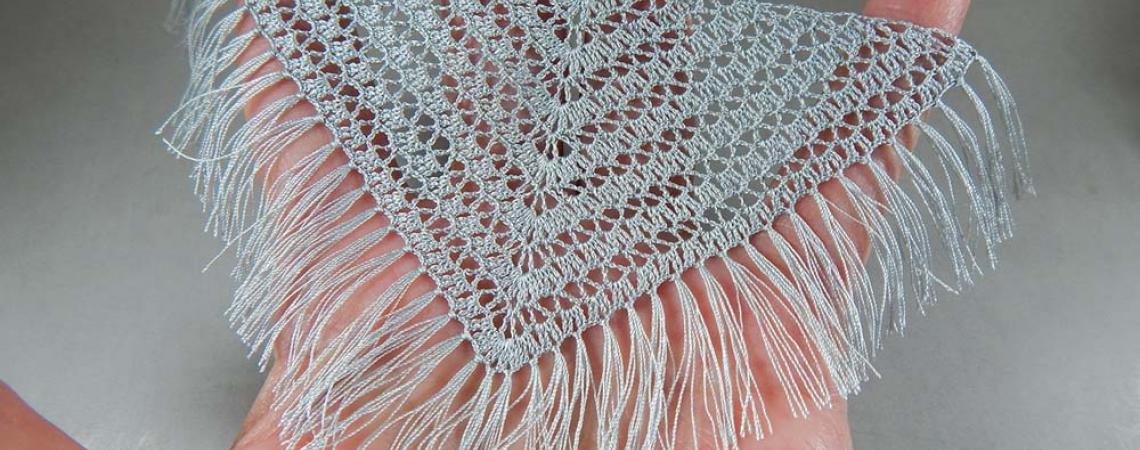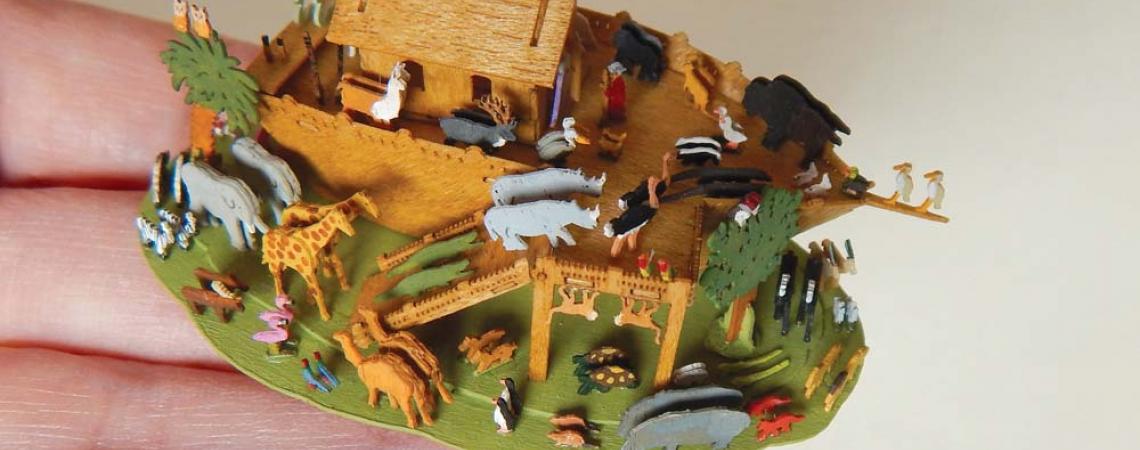Whether they’re furnishing realistic-looking rooms in a dollhouse or creating a unique tiny display, for folks who collect and create miniatures, it truly is a small, small world.
It’s also a precise world made to exacting scale. One inch usually represents 12 inches. Some miniaturists prefer a more challenging scale where 1 inch equals 24 or 48 inches. And there are even smaller scales for miniature displays — a 1/144 scale means that 1 inch represents 12 feet.
This five-story, 1/144-scale dollhouse created by Volker Arnold stands just 5 inches tall (Photo courtesy of Jean Gibson).
Some miniaturists buy completely finished items when they want to furnish a dollhouse or display. Other collectors buy furniture and other items from kits so that they have the fun of doing the craft and painting it however they wish.
The dollhouses that miniaturists enjoy furnishing are very different from dollhouses made for children. They are smaller and constructed to exact scale, and the furniture and other decorative items placed inside are too small and too expensive for children to play with.
Whether they’re furnishing realistic-looking rooms in a dollhouse or creating a unique tiny display, for folks who collect and create miniatures, it truly is a small, small world.
When she was a child, Jean Gibson of St. Louisville, a member of The Energy Cooperative in Newark, liked collecting the prizes that came in boxes of Cracker Jack. “They were miniatures, and I always loved miniature things,” she says.
What got her into the world of miniatures, however, was her needlework. “My mom taught me to crochet when I was about 10,” she says. “I took it up again years later when I was working at Newark Air Force Station.” About that time, she crocheted a full-size afghan, but she was discouraged by how much time and energy it took her to finish the afghan.
So she decided to make a smaller one.
Pleased with the result, Gibson started making fabric miniatures and selling them at regional shows for miniaturists. She had also learned how to do tatting and bobbin lacework to create decorative lace doilies and lace tablecloths.
“I would crochet afghans of silk sewing thread for beds in miniaturists’ dollhouses,” she says. “The 3 x 5-inch afghan would be made up of 96 squares.”
About 15 years ago at a miniatures show in Chicago, Gibson saw miniature furniture made in Germany by master miniatures craftsman Volker Arnold. She was so impressed by the quality and detail of Arnold’s work that she decided to become a representative for him at shows.
Imagine a tiny wardrobe, 1 inch tall, for a dollhouse bedroom. With seven tiny hangers. And with drawers that open and close. Gibson says that degree of detail is typical for high-quality miniature items such as Arnold’s.
Gibson has been involved with miniatures for over 40 years. “I just love them! The colors are so pretty when they’re finished. When someone wants to buy a miniature item I have made, it’s a validation,” she says.
She sells Arnold’s laser-cut, ready-to-assemble miniature furniture kits and other miniature items at shows and through her Etsy store.
She assembles some of every kit item so that she can answer questions from customers. She sells her finished items and also does custom work for some customers.
Gibson enjoys seeing the work of other miniaturists. “The more real things look, the better,” she says. “At some of the big shows, I’ve seen miniature foods that look real enough to make you hungry,” she says.
Magnifying glasses or microscopes often come in handy for working with miniatures, whether assembling a display from a kit of tiny parts or creating one’s own display. So do tiny paint brushes and tweezers of various sizes.
“I learned long ago that fingers are way too big [for working with miniatures],” Gibson explains.
Gibson finds the hardest part of creating miniatures is that “it’s very time-consuming. I can work 10 hours straight.” She says that painting miniature items can be difficult during the colder months. “The paint has to be the perfect consistency, but heated air dries it out, so it gets too hard.”
Bunnyland is a favorite miniatures project Gibson created. Her display features rabbits enjoying an amusement park. The carousel, large and small Ferris wheels, other rides, and eight different food shops all fit into a 9 x 11-inch frame.
Want to get started?
The National Association of Miniature Enthusiasts (NAME) is located in Carmel, Indiana. The organization’s website lists several Ohio clubs for miniatures fans — in Cleveland, Toledo, Columbus, Cincinnati, Akron, West Chester, Findlay, Lima, Strongsville, and Warren. Most of the clubs meet once or twice a month. They welcome visitors who are at least 16 years old.
Call 317-571-8094 for information.














